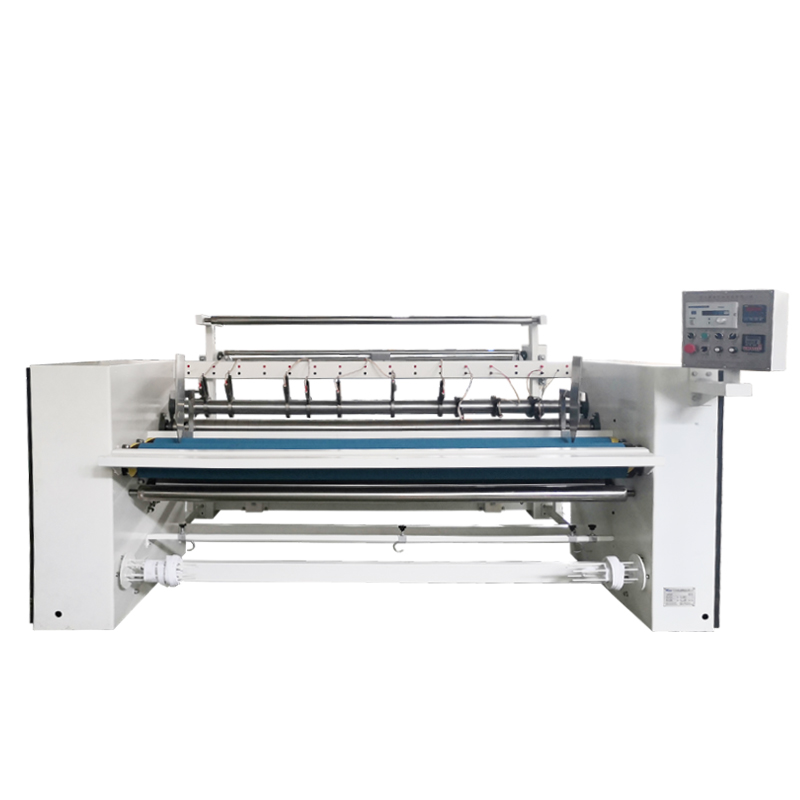REHOW fabric slitting machine is versatile and widely used in various textile applications, including clothing, home textiles, automotive textiles, medical textiles, etc. This blog will discuss the importance and economic status of slitting machines in the textile industry.
RH-400A Fabric Slitting Machine
Fabric slitters are designed to handle a wide variety of fabrics and are vital in the textile industry, and the importance of fabric slitters is self-evident.
1. The operation of a fabric slitting machine usually involves unrolling a large roll of fabric, passing it through a series of rollers, and cutting it into smaller rolls of the desired width. The machine is equipped with multiple functions, such as adjustable cutting blades, tension control system, edge guiding mechanism, automatic feeding and winding system, to ensure precise cutting, uniform rolling and smooth production process.
2. One of the main advantages of the fabric slitting machine is its ability to increase the efficiency and productivity of textile manufacturing. By converting large rolls of fabric into smaller rolls, the slitter allows smooth handling, storage and transport of fabrics, optimizing production processes and reducing material waste. It also allows for better inventory management, as smaller rolls are easier to count, access, and ship according to production requirements, reducing inventory costs and improving supply chain management.
3. The fabric slitting machine also provides customization and production flexibility. Manufacturers can easily configure machines to cut fabrics in different widths, lengths and gauges to produce textiles with specific requirements or properties. This flexibility enables textile manufacturers to meet the diverse needs of customers, offer a wide range of products, and enter different market segments, thereby expanding business prospects and revenue streams.
4. Precise cutting and trimming of fabrics ensures clean and finished edges, eliminates defects and inconsistencies, and produces high-quality textiles that meet customer expectations. This helps manufacturers maintain their reputation for producing high-quality textiles, resulting in increased customer loyalty, repeat business and positive word-of-mouth, which boosts sales and revenue.
5. Fabric slitters can produce fabrics with special features or finishes, such as sealed edges or seams, which add value to textiles, making them more durable, aesthetically pleasing, and suitable for specific applications. Value-added textiles can command higher prices in the market, thereby increasing the revenue and profitability of textile manufacturers.
6. The fabric slitting machine is designed to optimize the cutting process and minimize the width of the sides or sides, thereby increasing the output and utilization of fabrics. This helps manufacturers reduce material costs, reduce waste and improve overall cost-effectiveness.
7. In addition, the fabric slitting machine helps to improve the beauty and appearance of the product. Precise cutting and trimming of the fabric ensures clean edges for visually appealing textiles. This enhances the overall appearance and presentation of the final product, making it more attractive to customers and potentially commanding higher prices in the market, thereby increasing revenue and profitability.
Nowadays, in the process of carrying out production operations, I believe that everyone will be more inclined to choose a simpler and more effective way of working. And for users and friends who use slitter equipment, they also hope to find such a working method. That is to say, from the user’s point of view, their requirements for slitter equipment can be summarized as simple operation, high quality and high efficiency.
To further introduce, in the future production work, people will have stricter performance requirements for slitting machine equipment. Not only do they hope to ensure high precision, but they also need to have a mature and simple operating system and high work efficiency. However, in actual production operations, it is difficult to satisfy all these requirements at the same time.
This is because in the slitting machine equipment, it includes different operating units, and even if the connection between these different parts meets the requirements of very high accuracy, after a long period of continuous operation, it is still inevitable that there will be some error. These errors will gradually affect the final processing quality of the equipment. In order to reduce these errors as much as possible, in the process of operation, a suitable operation method should be selected and each parameter should be set reasonably.
More importantly, during the production process, the user must choose a suitable tool for the slitting machine equipment based on the specific production requirements. And when configuring the tool, carefully consider the requirements for its accuracy. In this way, the error can be effectively controlled and the precision can be improved.
In short, based on the requirements for future production and other aspects, whether it is manufacturing slitting machine equipment or selecting and using slitting machine equipment, producers and users must take effective measures as much as possible to ensure final production. quality.
Post time: May-05-2023






